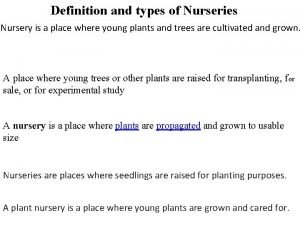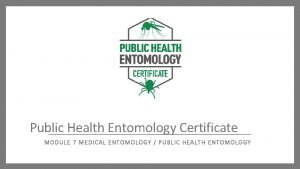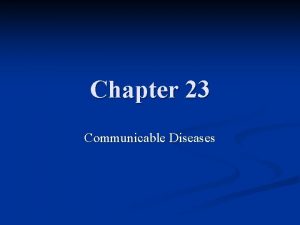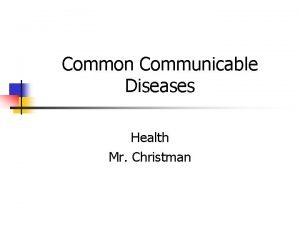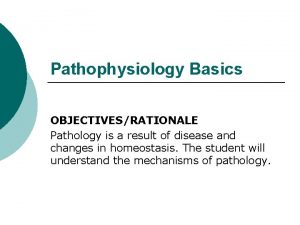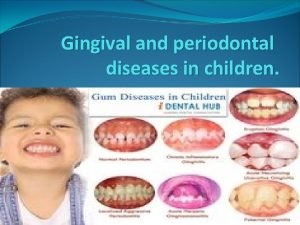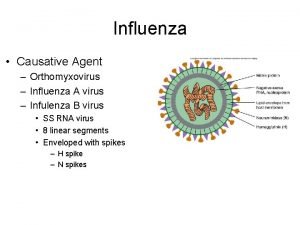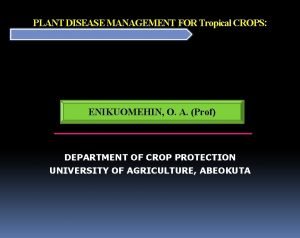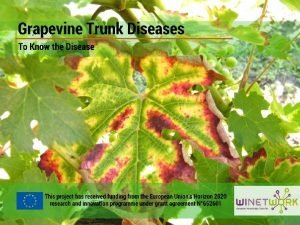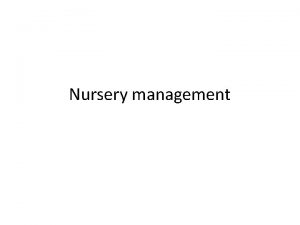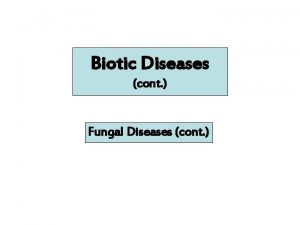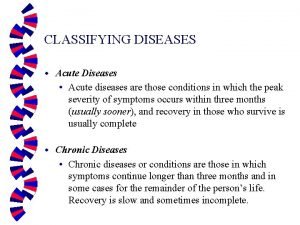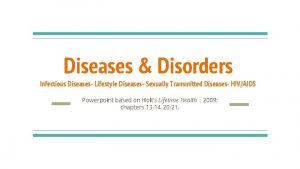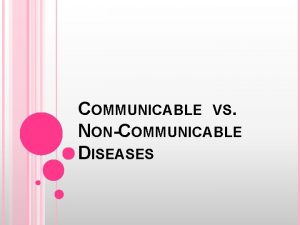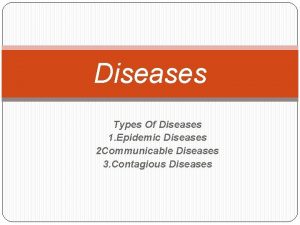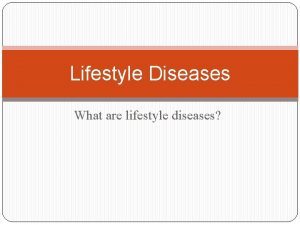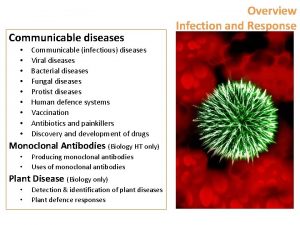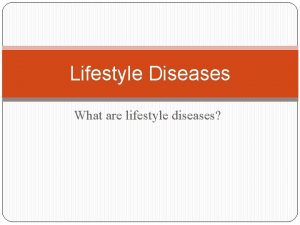Nursery diseases Nursery environment Nursery environment is a
















- Slides: 16

Nursery diseases

Nursery environment • Nursery environment is a highly artificial one – Large number of even-aged young seedlings – Homogeneous, monospecific conditions – Irrigation, fertilizers • Reforestation in the last 30 -40 years has made it necessary to generate millions of seedlings • Nursery industry evolved rapidly to improve production, develop new approaches, mechanize operations and develop large scale operations

Growing conditions in nurseries • Bareroot nurseries – Seedlings grown in the soil, usually in agricultural lands – Exposed to natural microflora in the soil – Seedlings usually grown in dense seedbeds – Natural and artificial irrigation • Container nurseries – Seedlings grown in artificial containers in soil mixtures – Container cavities usually small, allowing 1 -2 years of growth – Because of small cavities, overhead artificial irrigation necessary • Foliage disease problems most important • Opportunistic pathogens frequent

Types of nursery diseases • • Large number of nursery diseases – All host trees affected – Some are opportunistic (e. g. mold), some specialized (e. g. rust) Most nursery diseases belong to the following groups – Root rots, shoot blights, cankers, foliar diseases, abiotic stress • Some pathogens causing diseases in nurseries are the same as those causing disease in natural forests or plantation – Rusts, foliar pathogens – This can mean that the pathogens can spread from nurseries to plantations or reforestation sites • For other diseases, such as root rots, a completely different group of pathogens are causal agents – Shift from basidiomycetes to ascomycetes, and from more specialized to more generalist (with some exceptions) • But some diseases are unique to seedlings – Damping-off, grey mold, seed-borne diseases

Damping-off • • • Failure of seeds to germinate or collapse of seedlings soon after germination Pre-emergence damping-off: before the seedlings emerges; Post-emergence damping-off: after emergence Often caused by fungi, but also can be caused by water-molds (Oomycetes, which were long believed to be fungi) – • • • Four genera (Pythium, Fusarium, Phytophthora, and Rhizoctonia) are important causal agents of damping-off These pathogens are soilborne or seedborne and are stimulated to grow and infect the seed or seedling by nutrients released from a germinating seed Damping-off can affect any host species and the fungi are generally non-specialized The pathogen causing damping-off cannot be determined on the basis of symptoms – – Identification usually requires culturing of infected tissues and microscopic examinations Such identification is usually necessary before specific control recommendations can be made

Damping-off occurrence • • Damping-off disease of seedlings is widely distributed and is a problem worldwide It occurs in most soils, temperate and tropical climates, and in greenhouses The disease affects seeds and seedlings of various crops The amount of damage the disease causes to seedbeds depends on the fungus, soil moisture, and temperature – Cool, wet soils with high p. H generally favor development of the disease – However, portions of the roots and stems still can be attacked by some of the pathogens causing damping-off, such as Fusarium and Phytophthora, resulting in poor growth and reduced yields Seedlings in seedbeds often are completely destroyed by damping-off, or they die after transplanting Frequently, germinating seeds are killed by damping-off fungi before they emerge from the ground, which accounts for poor stands in many crops Older plants are seldom killed by damping-off fungi mainly because the development of secondary stem tissue forms a protective barrier and limits fungal penetration.

Symptoms of damping-off • Pre-emergence damping-off is difficult to diagnose: people often attribute is to « poor seeds » . • Infected seed becomes soft and mushy turning a brown to black color, and it eventually disintegrates • Seeds that have germinated and become infected develop water-soaked spots that enlarge and turn brown • The classic symptoms of postemergence damping-off include decay of the seedling hypocotyl at the ground line, causing the seedling to topple over. • Seedlings that have emerged are usually attacked at or below the soil line. The organism can easily penetrate the young soft stem tissue. The infected stem portion becomes discolored and begins to shrink. As this occurs, the supportive strength of the stem's invaded portion is lost, and the seedling topples over • The fungi continue to invade the remaining portion of the seedling, resulting in death. This phase of the disease is termed postemergence damping-off. • Older established plants also can be attacked by dampingoff fungi. Usually the new developing rootlets are infected, resulting in root rot. Infected plants show symptoms of wilting and poor growth.

Biology of damping-off • • Most damping-off fungi survive in the soil or in plant debris as dormant spores resistant to environmental extremes. They tend to increase when seedbeds are used continuously without cover crop rotation Damping-off organisms may be endemic in nursery soil without causing damage but may cause serious problems when environmental conditions are favorable for one or more of the pathogens but unfavorable for early seedling growth Damping-off pathogens can also be present in growing mix: peat moss, etc. The principal environmental factors influencing disease development are soil p. H, moisture, and temperature; effects of these factors vary with the predominant pathogen and the tree species

Biology of damping-off • • • All damping-off pathogens grow and reproduce best when the p. H of soil or growth medium is above the optimum for seedling growth (p. H 5. 2 to 5. 8) Cool, wet soils slow germination and extend the time seeds and germinating seedlings are exposed to pathogens: losses to damping-off increase under such conditions. Excessive soil moisture at moderate temperature favors development of Pythium and Phytophthora spp. which have motile zoospores Soil texture, organic amendments, and nutrients can also influence disease development. Fine-textured soils with a high clay content retain water and warm slowly in the spring Within the same seedbed, the soil environment is highly variable, which may explain why seedling damage is sporadic and usually occurs in pockets

Mode of action of damping-off • Damping-off pathogens take advantage of the fact that seedlings don’t have yet protective layers • Succulent tissues are exposed and are extremely susceptible to enzymatic action • Damping-off pathogens use a cocktail of enzymes to macerate and degrade the host tissues and utilise the carbohydrates and nutrients

Source of pathogen in container nursery • Seedborne fungi are a primary source of inoculum for damping-off fungi in container nurseries. • Rhizoctonia, Pythium, and Phytophthora spp. are primarily spread through contaminated irrigation water or growing media, especially from mixes containing soil • In container nurseries, pathogens usually don’t spread from seedling to seedling – Container cavities isolate the seedlings from one another

Cultural Control • High soil p. H, inadequate soil drainage, and low soil temperatures when seedlings are germinating can sometimes be modified by proper cultural practices • Lower the soil p. H by adding certain sulfur compounds (granular sulfur or ammonium sulfate) or inorganic acids (sulfuric acid) • In bareroot nurseries, improve soil drainage by leveling soil, by installing subsurface drainage tiles, and by adjusting the frequency of irrigation • Irrigation must also be carefully controlled in container nurseries; drip irrigation whenever possible • Minimize exposure of seeds to soil pathogens by delaying sowing until the soil temperature has risen to near optimum for rapid seed germination. Chemical • Soil fumigation is the most effective way to control damping-off (in the short term!) • The currently recommended chemicals are mixtures of methyl bromide and Chloropicrin • But these fumigants are under a ban because of their effect on the ozone layer • Unfortunately, fumigation reduces populations of all soil-inhabiting organisms, including the beneficial ones • In addition, treated areas can become rapidly reinfested by contaminated soil, mulches, irrigation water, or seed • Soil fungicide drenches are effective against some damping-off fungi in container nurseries • To use this approach, the pathogen causing the disease must be correctly identified; many modern fungicides are effective only on certain groups of related fungi • Soil drenches to control damping-off have also been widely applied in bareroot nurseries, but the results are unpredictable

Root diseases of seedlings • Cylindrocladium root rot – Severe root disease of seedlings – Hosts in over 30 genera – Multiple dark brown-black lesions on roots – Foliage stunted, wilted – Produces long-lasting resting structures called microsclerotia that survive in soil for decades – Phytosanitary control: cull and destroy infected seedlings – Fumigation, cultural control

Grey mold • • • Caused by the fungus Botrytis cinerea Opportunistic fungus that can grow saprophytically; Botrytis is a very common contaminant One of most damaging pest of conifer seedlings in container tree nurseries Grey mold attacks most species of container seedlings but certain species are particularly susceptible: western larch, lodgepole pine, Engelmann spruce, and ponderosa pine, western hemlock and Douglas-fir Grey, cottony mycelia and spore masses on the surface of affected shoot tissue, especially on senescent needles of the lower shoot. B. cinerea spores can be introduced into a container nursery in the air, on seeds, or in irrigation water

Control of grey mold Cultural – Keep seedlings healthy and vigorous and avoid injuring the foliage. Fertilizer-burned or frost- damaged foliage is particularly susceptible to Botrytis infection. – • Avoid overly dense seedling growing levels by selecting a container that allows adequate spacing for seedling development. Containers can also be placed at a wider spacing to allow better air circulation during periods when seedlings are especially vulnerable. – Reduce the time that seedling foliage is wet by encouraging air circulation, irrigating early in the day, using surfactants in the irrigation water, providing underbench heating, or force-drying foliage with fans. – Follow a strict sanitation policy that includes removal and destruction of all plant debris, prompt roguing of infected seedlings, and sterilization of containers and growing area surfaces between crops. Chemical – All fungicides registered for the control of grey mold are protectants that must be applied before infection takes place – • There a number of chemicals registered for controlling B. cinerea on ornamental plants, but not all of these are registered for tree seedlings – New chemicals are also continually being developed, so growers should monitor trade publications and check with a certified pesticide specialist for up-to-date information – BUT: Botrytis is continually adapting to fungicides and developing resistance

Diseases spreading from the nursery • Some diseases infect seedlings in the nurseries and can be transmitted to the reforestation site or to the plantation • Often, pathogens can infect host and remain as endophytes (fungi that grow within the host without causing symptoms) • Some diseases appear only after the transplantation when the seedling buds open (e. g. Scleroderris canker) • Other diseases appear after several years, e. g. pine rusts whose life cycle can take several years)
 Nursery types
Nursery types Environment of business finance
Environment of business finance Zoonotic diseases
Zoonotic diseases Sarophytes
Sarophytes Sperm fructose
Sperm fructose Non common communicable diseases
Non common communicable diseases What causes genetic diseases
What causes genetic diseases Is hemophilia communicable or noncommunicable
Is hemophilia communicable or noncommunicable Retrocuspid papilla interdental clefts in primary teeth
Retrocuspid papilla interdental clefts in primary teeth Flu causative agent
Flu causative agent Protein deficiency diseases
Protein deficiency diseases Conclusion of plant diseases
Conclusion of plant diseases Chapter 15 nervous system diseases and disorders
Chapter 15 nervous system diseases and disorders Diseases with vaccines
Diseases with vaccines Chapter 6 musculoskeletal system diseases and disorders
Chapter 6 musculoskeletal system diseases and disorders Grapevine trunk diseases
Grapevine trunk diseases Cardiovascular system diseases and disorders chapter 8
Cardiovascular system diseases and disorders chapter 8
